Strategic Management and Leadership: Team Dynamics Analysis Report
VerifiedAdded on 2021/12/27
|10
|2926
|21
Report
AI Summary
This report delves into the critical aspects of team cohesion, exploring its significance in strategic management and leadership. It examines the concept of team cohesion, its impact on performance, and the factors that contribute to it, such as shared goals, interpersonal relationships, and effective communication. The report introduces Huszczo's theory, emphasizing the need for active reinforcement systems, clear responsibilities, and a shared sense of direction. It also discusses Belbin's theory of team roles, highlighting the diverse behaviors essential for team success. Furthermore, the report provides strategies for developing team cohesion, including valuing contributions, empowering members, and resolving conflicts. It also addresses team participation and its role in optimal performance, with a focus on creating the right team structure and encouraging active participation. The report analyzes a case study, identifying and offering solutions to common team challenges such as poor communication, falling cooperation, and task prioritization. It also discusses Thomas Kilmann’s model of conflict resolution and how it can improve cooperation. Overall, the report provides a comprehensive overview of team dynamics, offering insights and practical strategies for building and managing high-performing teams.
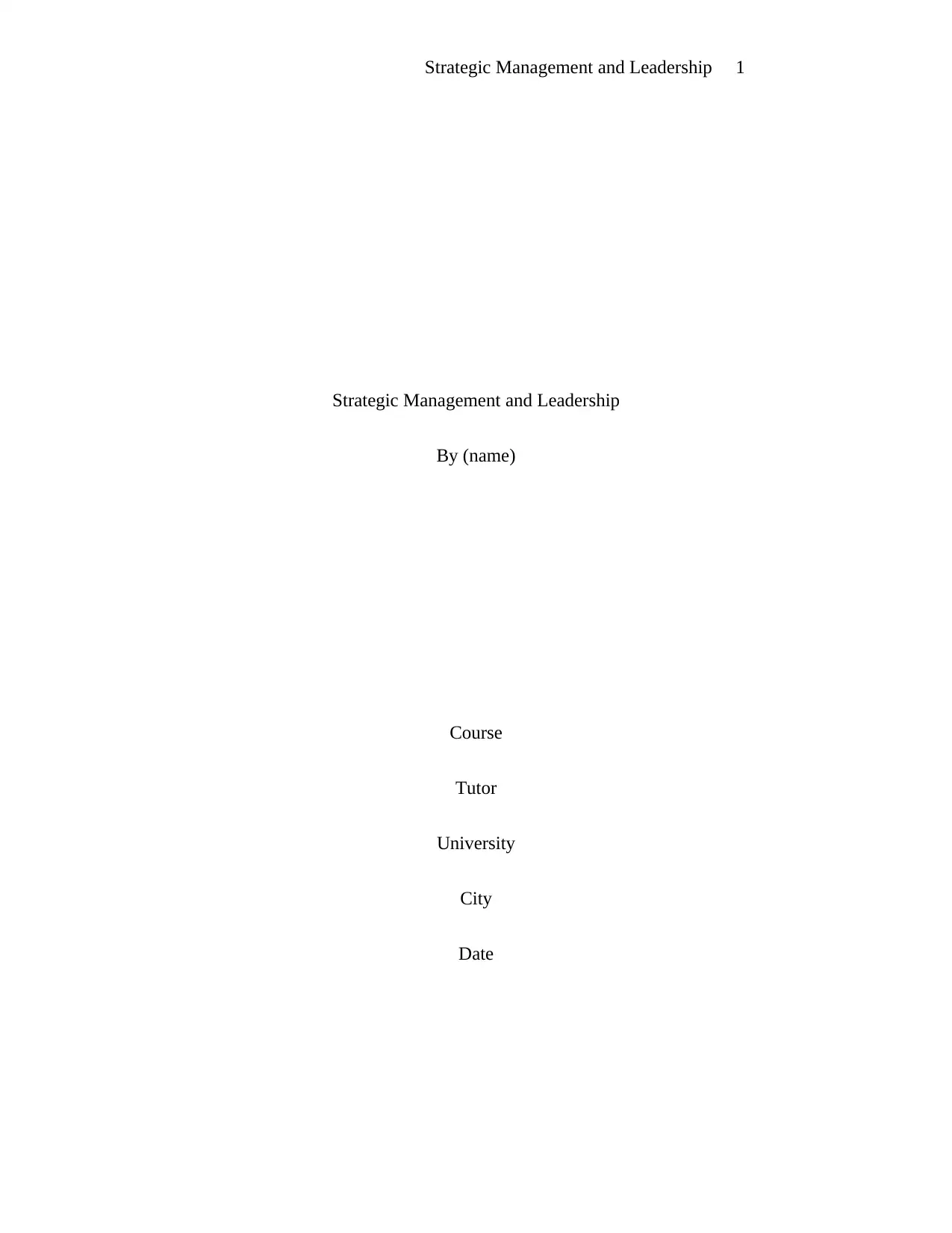
Strategic Management and Leadership 1
Strategic Management and Leadership
By (name)
Course
Tutor
University
City
Date
Strategic Management and Leadership
By (name)
Course
Tutor
University
City
Date
Paraphrase This Document
Need a fresh take? Get an instant paraphrase of this document with our AI Paraphraser

Strategic Management and Leadership 2
Despite diversity on cultural backgrounds, skill levels and work experience there should
always be cohesion in team work. Team cohesion leads to true success because with it comes
decreased anxiety, team member self-esteem and work satisfaction. Team cohesion is an attitude
of togetherness in any given team. In other words, it is an interpersonal connection that results
from strength that exists among group members (McMillan, Morris and Atchley, 2011, p8). The
connection the team has, builds a bond amongst the group members such that they are always
motivated and ready to participate in accomplishment of goals that have been set (Baker, Day
and Salas, 2010, p1577). In order to make this work, there are tools for team excellence
according to Professor Gregory Huszczo.
Huszczo Theory
Huszczo holds that, in order to achieve excellence, a team should have active
reinforcement system (Huszczo, 2009, p3). This ensures that every member is accountable such
that they will all avoid doing what they are not supposed to do to avoid repercussions.
Additionally, it puts in place rewards for positive behaviors and outcomes. This serves as a
motivation for doing great things in team work hence avoiding all that could lead to negative
outcomes. Secondly, there must be clear and enticing responsibilities such that each group
member understands what their role is. This ensures that there is no task left unattended to.
However, responsibilities are delegated depending on the member’s expertise to improve
effectiveness and efficiency. Also, it makes the team be aware of who to report to in case of a
problem or consultation so as to avoid confusion. Thirdly, it should have a clear sense of
direction in that, all the members have a shared purpose and understand what the outcomes
should be hence know how to corporate to achieve the purpose as a team. Most importantly, the
team should have interpersonal relationships that are constructive. This results the members to
Despite diversity on cultural backgrounds, skill levels and work experience there should
always be cohesion in team work. Team cohesion leads to true success because with it comes
decreased anxiety, team member self-esteem and work satisfaction. Team cohesion is an attitude
of togetherness in any given team. In other words, it is an interpersonal connection that results
from strength that exists among group members (McMillan, Morris and Atchley, 2011, p8). The
connection the team has, builds a bond amongst the group members such that they are always
motivated and ready to participate in accomplishment of goals that have been set (Baker, Day
and Salas, 2010, p1577). In order to make this work, there are tools for team excellence
according to Professor Gregory Huszczo.
Huszczo Theory
Huszczo holds that, in order to achieve excellence, a team should have active
reinforcement system (Huszczo, 2009, p3). This ensures that every member is accountable such
that they will all avoid doing what they are not supposed to do to avoid repercussions.
Additionally, it puts in place rewards for positive behaviors and outcomes. This serves as a
motivation for doing great things in team work hence avoiding all that could lead to negative
outcomes. Secondly, there must be clear and enticing responsibilities such that each group
member understands what their role is. This ensures that there is no task left unattended to.
However, responsibilities are delegated depending on the member’s expertise to improve
effectiveness and efficiency. Also, it makes the team be aware of who to report to in case of a
problem or consultation so as to avoid confusion. Thirdly, it should have a clear sense of
direction in that, all the members have a shared purpose and understand what the outcomes
should be hence know how to corporate to achieve the purpose as a team. Most importantly, the
team should have interpersonal relationships that are constructive. This results the members to
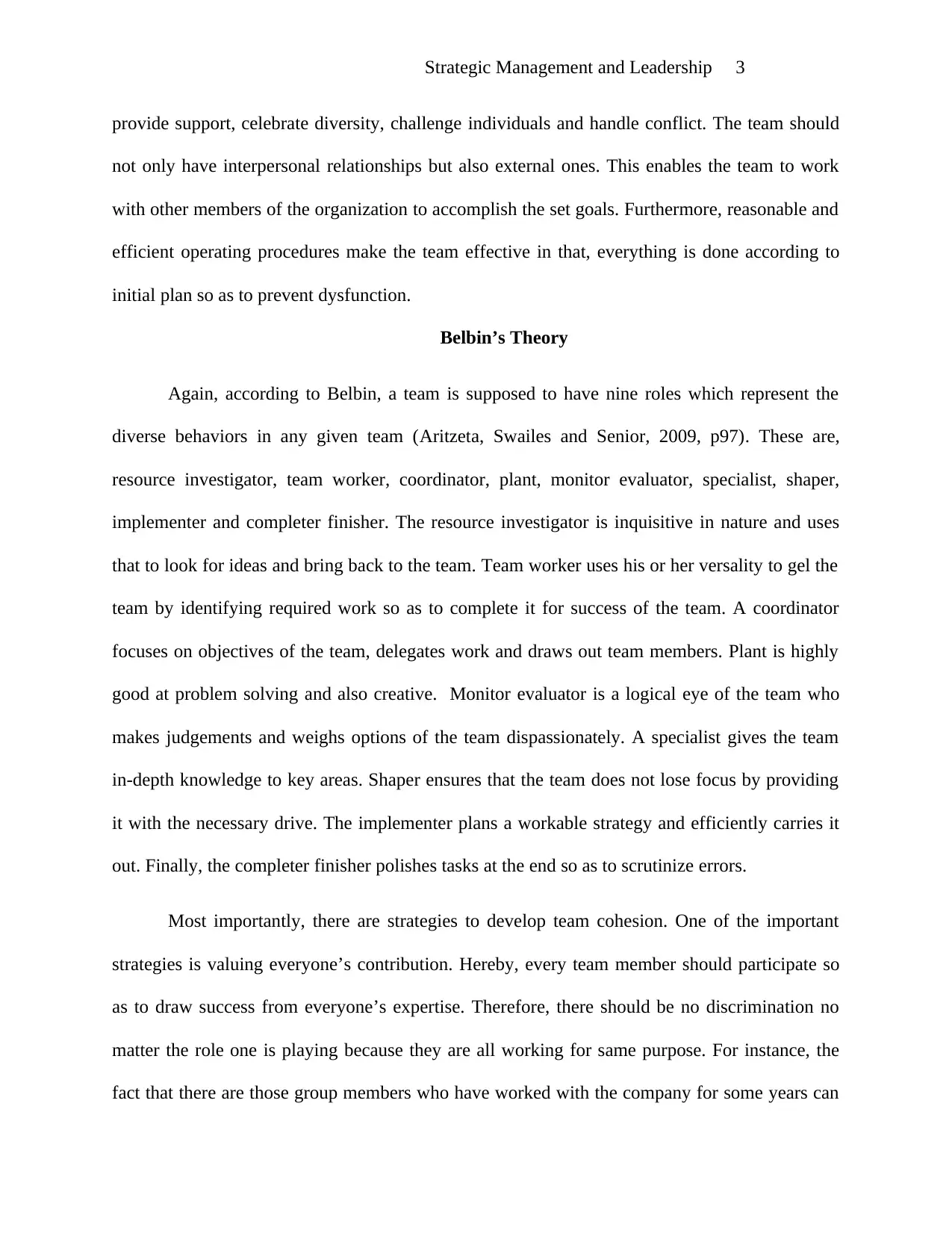
Strategic Management and Leadership 3
provide support, celebrate diversity, challenge individuals and handle conflict. The team should
not only have interpersonal relationships but also external ones. This enables the team to work
with other members of the organization to accomplish the set goals. Furthermore, reasonable and
efficient operating procedures make the team effective in that, everything is done according to
initial plan so as to prevent dysfunction.
Belbin’s Theory
Again, according to Belbin, a team is supposed to have nine roles which represent the
diverse behaviors in any given team (Aritzeta, Swailes and Senior, 2009, p97). These are,
resource investigator, team worker, coordinator, plant, monitor evaluator, specialist, shaper,
implementer and completer finisher. The resource investigator is inquisitive in nature and uses
that to look for ideas and bring back to the team. Team worker uses his or her versality to gel the
team by identifying required work so as to complete it for success of the team. A coordinator
focuses on objectives of the team, delegates work and draws out team members. Plant is highly
good at problem solving and also creative. Monitor evaluator is a logical eye of the team who
makes judgements and weighs options of the team dispassionately. A specialist gives the team
in-depth knowledge to key areas. Shaper ensures that the team does not lose focus by providing
it with the necessary drive. The implementer plans a workable strategy and efficiently carries it
out. Finally, the completer finisher polishes tasks at the end so as to scrutinize errors.
Most importantly, there are strategies to develop team cohesion. One of the important
strategies is valuing everyone’s contribution. Hereby, every team member should participate so
as to draw success from everyone’s expertise. Therefore, there should be no discrimination no
matter the role one is playing because they are all working for same purpose. For instance, the
fact that there are those group members who have worked with the company for some years can
provide support, celebrate diversity, challenge individuals and handle conflict. The team should
not only have interpersonal relationships but also external ones. This enables the team to work
with other members of the organization to accomplish the set goals. Furthermore, reasonable and
efficient operating procedures make the team effective in that, everything is done according to
initial plan so as to prevent dysfunction.
Belbin’s Theory
Again, according to Belbin, a team is supposed to have nine roles which represent the
diverse behaviors in any given team (Aritzeta, Swailes and Senior, 2009, p97). These are,
resource investigator, team worker, coordinator, plant, monitor evaluator, specialist, shaper,
implementer and completer finisher. The resource investigator is inquisitive in nature and uses
that to look for ideas and bring back to the team. Team worker uses his or her versality to gel the
team by identifying required work so as to complete it for success of the team. A coordinator
focuses on objectives of the team, delegates work and draws out team members. Plant is highly
good at problem solving and also creative. Monitor evaluator is a logical eye of the team who
makes judgements and weighs options of the team dispassionately. A specialist gives the team
in-depth knowledge to key areas. Shaper ensures that the team does not lose focus by providing
it with the necessary drive. The implementer plans a workable strategy and efficiently carries it
out. Finally, the completer finisher polishes tasks at the end so as to scrutinize errors.
Most importantly, there are strategies to develop team cohesion. One of the important
strategies is valuing everyone’s contribution. Hereby, every team member should participate so
as to draw success from everyone’s expertise. Therefore, there should be no discrimination no
matter the role one is playing because they are all working for same purpose. For instance, the
fact that there are those group members who have worked with the company for some years can
⊘ This is a preview!⊘
Do you want full access?
Subscribe today to unlock all pages.

Trusted by 1+ million students worldwide
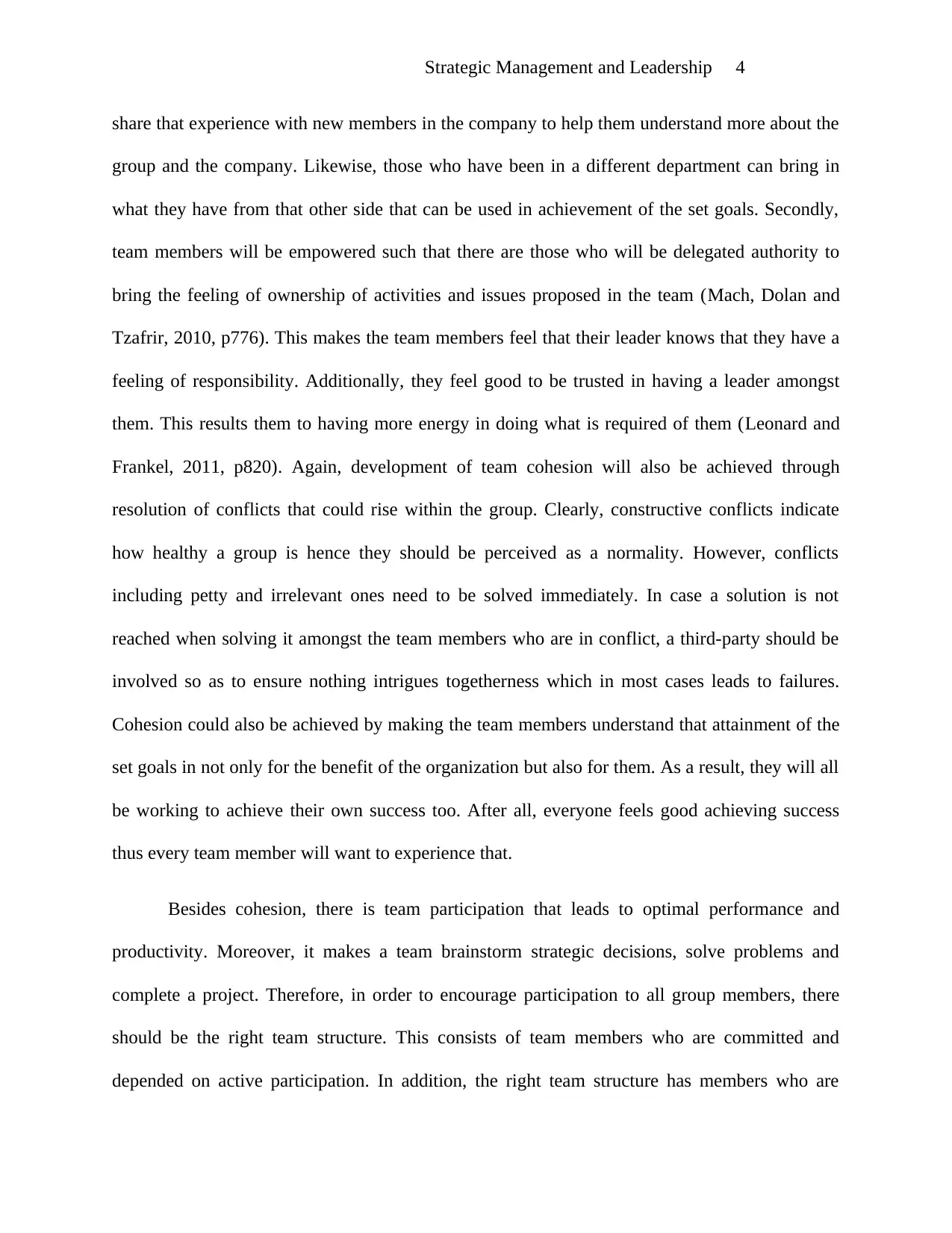
Strategic Management and Leadership 4
share that experience with new members in the company to help them understand more about the
group and the company. Likewise, those who have been in a different department can bring in
what they have from that other side that can be used in achievement of the set goals. Secondly,
team members will be empowered such that there are those who will be delegated authority to
bring the feeling of ownership of activities and issues proposed in the team (Mach, Dolan and
Tzafrir, 2010, p776). This makes the team members feel that their leader knows that they have a
feeling of responsibility. Additionally, they feel good to be trusted in having a leader amongst
them. This results them to having more energy in doing what is required of them (Leonard and
Frankel, 2011, p820). Again, development of team cohesion will also be achieved through
resolution of conflicts that could rise within the group. Clearly, constructive conflicts indicate
how healthy a group is hence they should be perceived as a normality. However, conflicts
including petty and irrelevant ones need to be solved immediately. In case a solution is not
reached when solving it amongst the team members who are in conflict, a third-party should be
involved so as to ensure nothing intrigues togetherness which in most cases leads to failures.
Cohesion could also be achieved by making the team members understand that attainment of the
set goals in not only for the benefit of the organization but also for them. As a result, they will all
be working to achieve their own success too. After all, everyone feels good achieving success
thus every team member will want to experience that.
Besides cohesion, there is team participation that leads to optimal performance and
productivity. Moreover, it makes a team brainstorm strategic decisions, solve problems and
complete a project. Therefore, in order to encourage participation to all group members, there
should be the right team structure. This consists of team members who are committed and
depended on active participation. In addition, the right team structure has members who are
share that experience with new members in the company to help them understand more about the
group and the company. Likewise, those who have been in a different department can bring in
what they have from that other side that can be used in achievement of the set goals. Secondly,
team members will be empowered such that there are those who will be delegated authority to
bring the feeling of ownership of activities and issues proposed in the team (Mach, Dolan and
Tzafrir, 2010, p776). This makes the team members feel that their leader knows that they have a
feeling of responsibility. Additionally, they feel good to be trusted in having a leader amongst
them. This results them to having more energy in doing what is required of them (Leonard and
Frankel, 2011, p820). Again, development of team cohesion will also be achieved through
resolution of conflicts that could rise within the group. Clearly, constructive conflicts indicate
how healthy a group is hence they should be perceived as a normality. However, conflicts
including petty and irrelevant ones need to be solved immediately. In case a solution is not
reached when solving it amongst the team members who are in conflict, a third-party should be
involved so as to ensure nothing intrigues togetherness which in most cases leads to failures.
Cohesion could also be achieved by making the team members understand that attainment of the
set goals in not only for the benefit of the organization but also for them. As a result, they will all
be working to achieve their own success too. After all, everyone feels good achieving success
thus every team member will want to experience that.
Besides cohesion, there is team participation that leads to optimal performance and
productivity. Moreover, it makes a team brainstorm strategic decisions, solve problems and
complete a project. Therefore, in order to encourage participation to all group members, there
should be the right team structure. This consists of team members who are committed and
depended on active participation. In addition, the right team structure has members who are
Paraphrase This Document
Need a fresh take? Get an instant paraphrase of this document with our AI Paraphraser
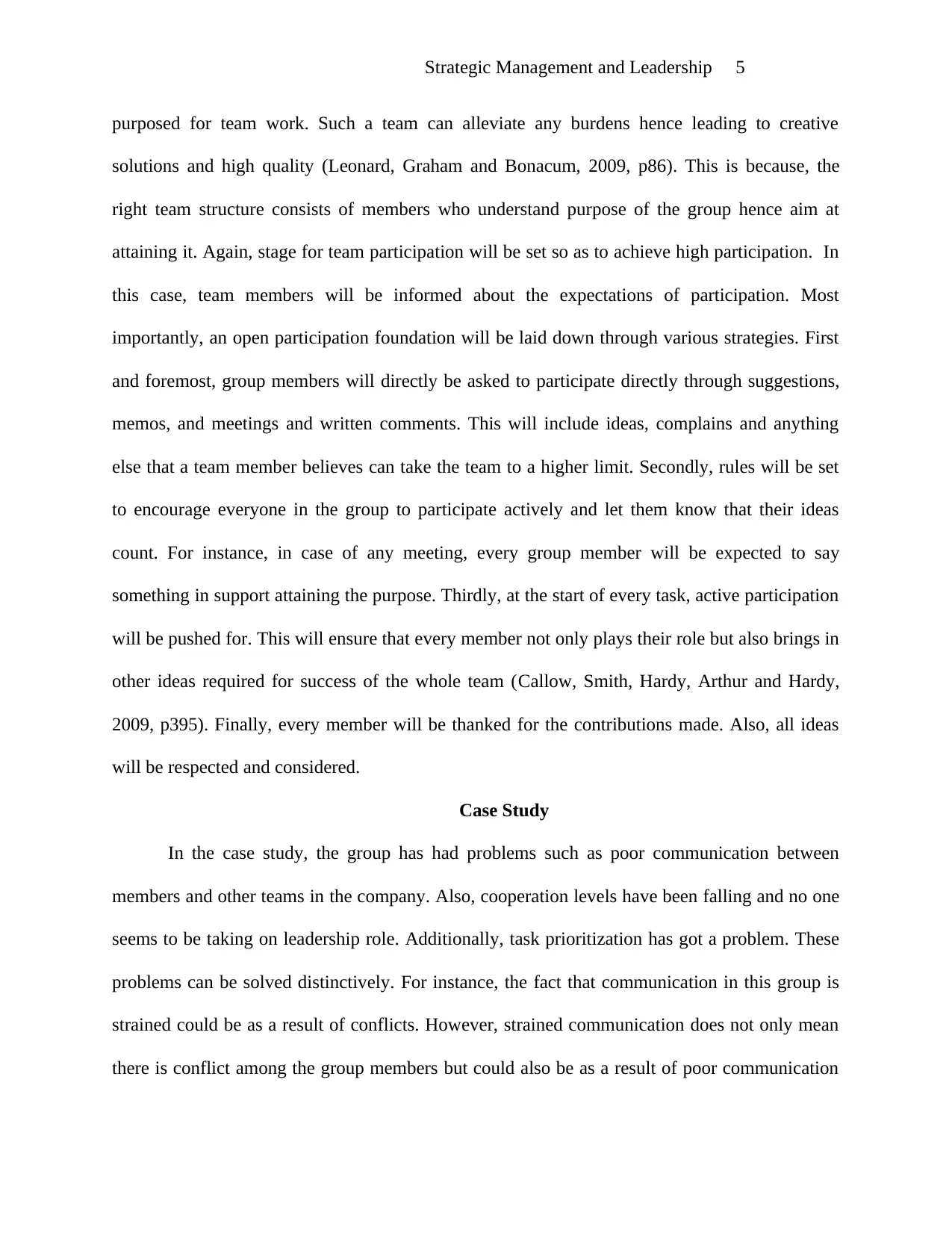
Strategic Management and Leadership 5
purposed for team work. Such a team can alleviate any burdens hence leading to creative
solutions and high quality (Leonard, Graham and Bonacum, 2009, p86). This is because, the
right team structure consists of members who understand purpose of the group hence aim at
attaining it. Again, stage for team participation will be set so as to achieve high participation. In
this case, team members will be informed about the expectations of participation. Most
importantly, an open participation foundation will be laid down through various strategies. First
and foremost, group members will directly be asked to participate directly through suggestions,
memos, and meetings and written comments. This will include ideas, complains and anything
else that a team member believes can take the team to a higher limit. Secondly, rules will be set
to encourage everyone in the group to participate actively and let them know that their ideas
count. For instance, in case of any meeting, every group member will be expected to say
something in support attaining the purpose. Thirdly, at the start of every task, active participation
will be pushed for. This will ensure that every member not only plays their role but also brings in
other ideas required for success of the whole team (Callow, Smith, Hardy, Arthur and Hardy,
2009, p395). Finally, every member will be thanked for the contributions made. Also, all ideas
will be respected and considered.
Case Study
In the case study, the group has had problems such as poor communication between
members and other teams in the company. Also, cooperation levels have been falling and no one
seems to be taking on leadership role. Additionally, task prioritization has got a problem. These
problems can be solved distinctively. For instance, the fact that communication in this group is
strained could be as a result of conflicts. However, strained communication does not only mean
there is conflict among the group members but could also be as a result of poor communication
purposed for team work. Such a team can alleviate any burdens hence leading to creative
solutions and high quality (Leonard, Graham and Bonacum, 2009, p86). This is because, the
right team structure consists of members who understand purpose of the group hence aim at
attaining it. Again, stage for team participation will be set so as to achieve high participation. In
this case, team members will be informed about the expectations of participation. Most
importantly, an open participation foundation will be laid down through various strategies. First
and foremost, group members will directly be asked to participate directly through suggestions,
memos, and meetings and written comments. This will include ideas, complains and anything
else that a team member believes can take the team to a higher limit. Secondly, rules will be set
to encourage everyone in the group to participate actively and let them know that their ideas
count. For instance, in case of any meeting, every group member will be expected to say
something in support attaining the purpose. Thirdly, at the start of every task, active participation
will be pushed for. This will ensure that every member not only plays their role but also brings in
other ideas required for success of the whole team (Callow, Smith, Hardy, Arthur and Hardy,
2009, p395). Finally, every member will be thanked for the contributions made. Also, all ideas
will be respected and considered.
Case Study
In the case study, the group has had problems such as poor communication between
members and other teams in the company. Also, cooperation levels have been falling and no one
seems to be taking on leadership role. Additionally, task prioritization has got a problem. These
problems can be solved distinctively. For instance, the fact that communication in this group is
strained could be as a result of conflicts. However, strained communication does not only mean
there is conflict among the group members but could also be as a result of poor communication
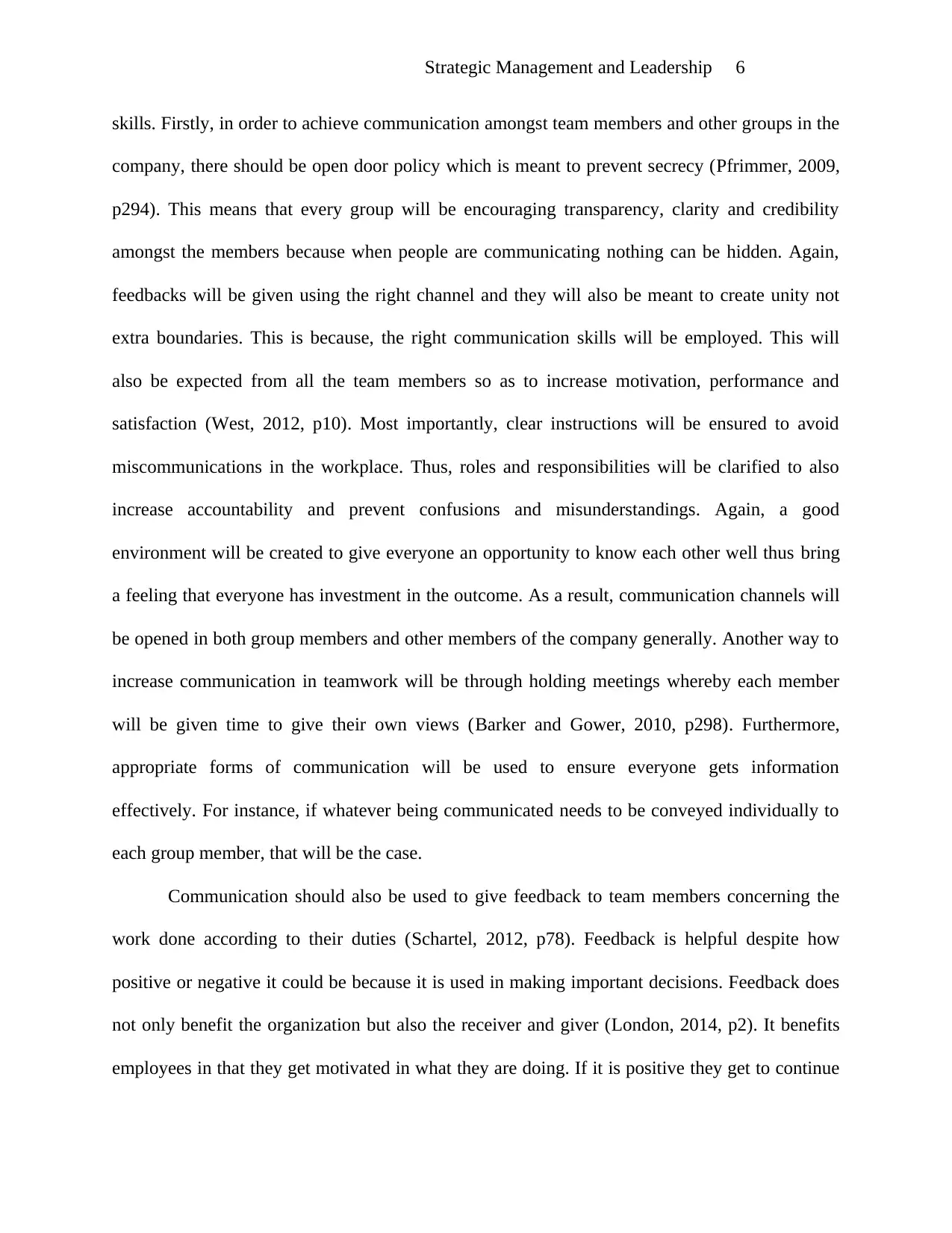
Strategic Management and Leadership 6
skills. Firstly, in order to achieve communication amongst team members and other groups in the
company, there should be open door policy which is meant to prevent secrecy (Pfrimmer, 2009,
p294). This means that every group will be encouraging transparency, clarity and credibility
amongst the members because when people are communicating nothing can be hidden. Again,
feedbacks will be given using the right channel and they will also be meant to create unity not
extra boundaries. This is because, the right communication skills will be employed. This will
also be expected from all the team members so as to increase motivation, performance and
satisfaction (West, 2012, p10). Most importantly, clear instructions will be ensured to avoid
miscommunications in the workplace. Thus, roles and responsibilities will be clarified to also
increase accountability and prevent confusions and misunderstandings. Again, a good
environment will be created to give everyone an opportunity to know each other well thus bring
a feeling that everyone has investment in the outcome. As a result, communication channels will
be opened in both group members and other members of the company generally. Another way to
increase communication in teamwork will be through holding meetings whereby each member
will be given time to give their own views (Barker and Gower, 2010, p298). Furthermore,
appropriate forms of communication will be used to ensure everyone gets information
effectively. For instance, if whatever being communicated needs to be conveyed individually to
each group member, that will be the case.
Communication should also be used to give feedback to team members concerning the
work done according to their duties (Schartel, 2012, p78). Feedback is helpful despite how
positive or negative it could be because it is used in making important decisions. Feedback does
not only benefit the organization but also the receiver and giver (London, 2014, p2). It benefits
employees in that they get motivated in what they are doing. If it is positive they get to continue
skills. Firstly, in order to achieve communication amongst team members and other groups in the
company, there should be open door policy which is meant to prevent secrecy (Pfrimmer, 2009,
p294). This means that every group will be encouraging transparency, clarity and credibility
amongst the members because when people are communicating nothing can be hidden. Again,
feedbacks will be given using the right channel and they will also be meant to create unity not
extra boundaries. This is because, the right communication skills will be employed. This will
also be expected from all the team members so as to increase motivation, performance and
satisfaction (West, 2012, p10). Most importantly, clear instructions will be ensured to avoid
miscommunications in the workplace. Thus, roles and responsibilities will be clarified to also
increase accountability and prevent confusions and misunderstandings. Again, a good
environment will be created to give everyone an opportunity to know each other well thus bring
a feeling that everyone has investment in the outcome. As a result, communication channels will
be opened in both group members and other members of the company generally. Another way to
increase communication in teamwork will be through holding meetings whereby each member
will be given time to give their own views (Barker and Gower, 2010, p298). Furthermore,
appropriate forms of communication will be used to ensure everyone gets information
effectively. For instance, if whatever being communicated needs to be conveyed individually to
each group member, that will be the case.
Communication should also be used to give feedback to team members concerning the
work done according to their duties (Schartel, 2012, p78). Feedback is helpful despite how
positive or negative it could be because it is used in making important decisions. Feedback does
not only benefit the organization but also the receiver and giver (London, 2014, p2). It benefits
employees in that they get motivated in what they are doing. If it is positive they get to continue
⊘ This is a preview!⊘
Do you want full access?
Subscribe today to unlock all pages.

Trusted by 1+ million students worldwide
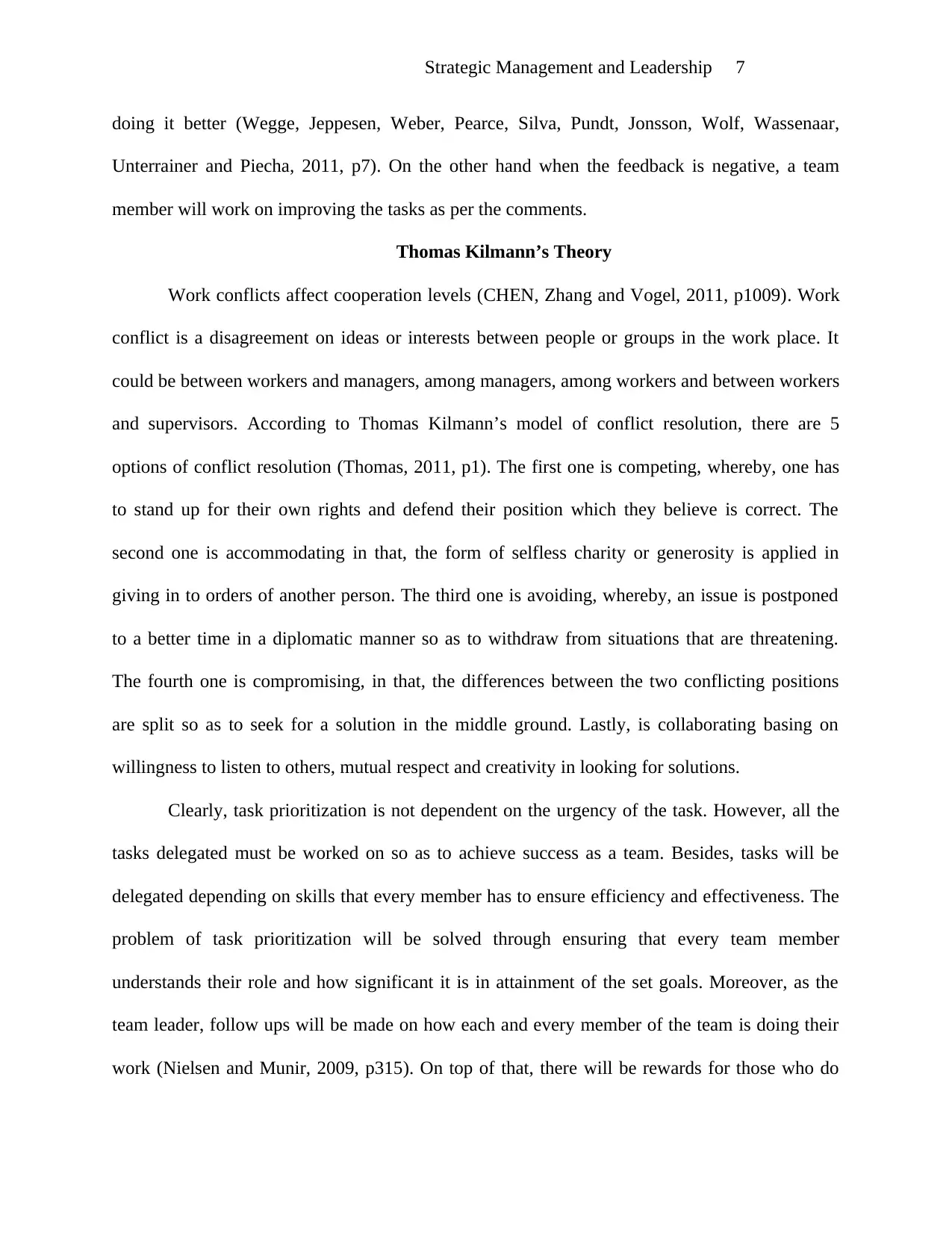
Strategic Management and Leadership 7
doing it better (Wegge, Jeppesen, Weber, Pearce, Silva, Pundt, Jonsson, Wolf, Wassenaar,
Unterrainer and Piecha, 2011, p7). On the other hand when the feedback is negative, a team
member will work on improving the tasks as per the comments.
Thomas Kilmann’s Theory
Work conflicts affect cooperation levels (CHEN, Zhang and Vogel, 2011, p1009). Work
conflict is a disagreement on ideas or interests between people or groups in the work place. It
could be between workers and managers, among managers, among workers and between workers
and supervisors. According to Thomas Kilmann’s model of conflict resolution, there are 5
options of conflict resolution (Thomas, 2011, p1). The first one is competing, whereby, one has
to stand up for their own rights and defend their position which they believe is correct. The
second one is accommodating in that, the form of selfless charity or generosity is applied in
giving in to orders of another person. The third one is avoiding, whereby, an issue is postponed
to a better time in a diplomatic manner so as to withdraw from situations that are threatening.
The fourth one is compromising, in that, the differences between the two conflicting positions
are split so as to seek for a solution in the middle ground. Lastly, is collaborating basing on
willingness to listen to others, mutual respect and creativity in looking for solutions.
Clearly, task prioritization is not dependent on the urgency of the task. However, all the
tasks delegated must be worked on so as to achieve success as a team. Besides, tasks will be
delegated depending on skills that every member has to ensure efficiency and effectiveness. The
problem of task prioritization will be solved through ensuring that every team member
understands their role and how significant it is in attainment of the set goals. Moreover, as the
team leader, follow ups will be made on how each and every member of the team is doing their
work (Nielsen and Munir, 2009, p315). On top of that, there will be rewards for those who do
doing it better (Wegge, Jeppesen, Weber, Pearce, Silva, Pundt, Jonsson, Wolf, Wassenaar,
Unterrainer and Piecha, 2011, p7). On the other hand when the feedback is negative, a team
member will work on improving the tasks as per the comments.
Thomas Kilmann’s Theory
Work conflicts affect cooperation levels (CHEN, Zhang and Vogel, 2011, p1009). Work
conflict is a disagreement on ideas or interests between people or groups in the work place. It
could be between workers and managers, among managers, among workers and between workers
and supervisors. According to Thomas Kilmann’s model of conflict resolution, there are 5
options of conflict resolution (Thomas, 2011, p1). The first one is competing, whereby, one has
to stand up for their own rights and defend their position which they believe is correct. The
second one is accommodating in that, the form of selfless charity or generosity is applied in
giving in to orders of another person. The third one is avoiding, whereby, an issue is postponed
to a better time in a diplomatic manner so as to withdraw from situations that are threatening.
The fourth one is compromising, in that, the differences between the two conflicting positions
are split so as to seek for a solution in the middle ground. Lastly, is collaborating basing on
willingness to listen to others, mutual respect and creativity in looking for solutions.
Clearly, task prioritization is not dependent on the urgency of the task. However, all the
tasks delegated must be worked on so as to achieve success as a team. Besides, tasks will be
delegated depending on skills that every member has to ensure efficiency and effectiveness. The
problem of task prioritization will be solved through ensuring that every team member
understands their role and how significant it is in attainment of the set goals. Moreover, as the
team leader, follow ups will be made on how each and every member of the team is doing their
work (Nielsen and Munir, 2009, p315). On top of that, there will be rewards for those who do
Paraphrase This Document
Need a fresh take? Get an instant paraphrase of this document with our AI Paraphraser
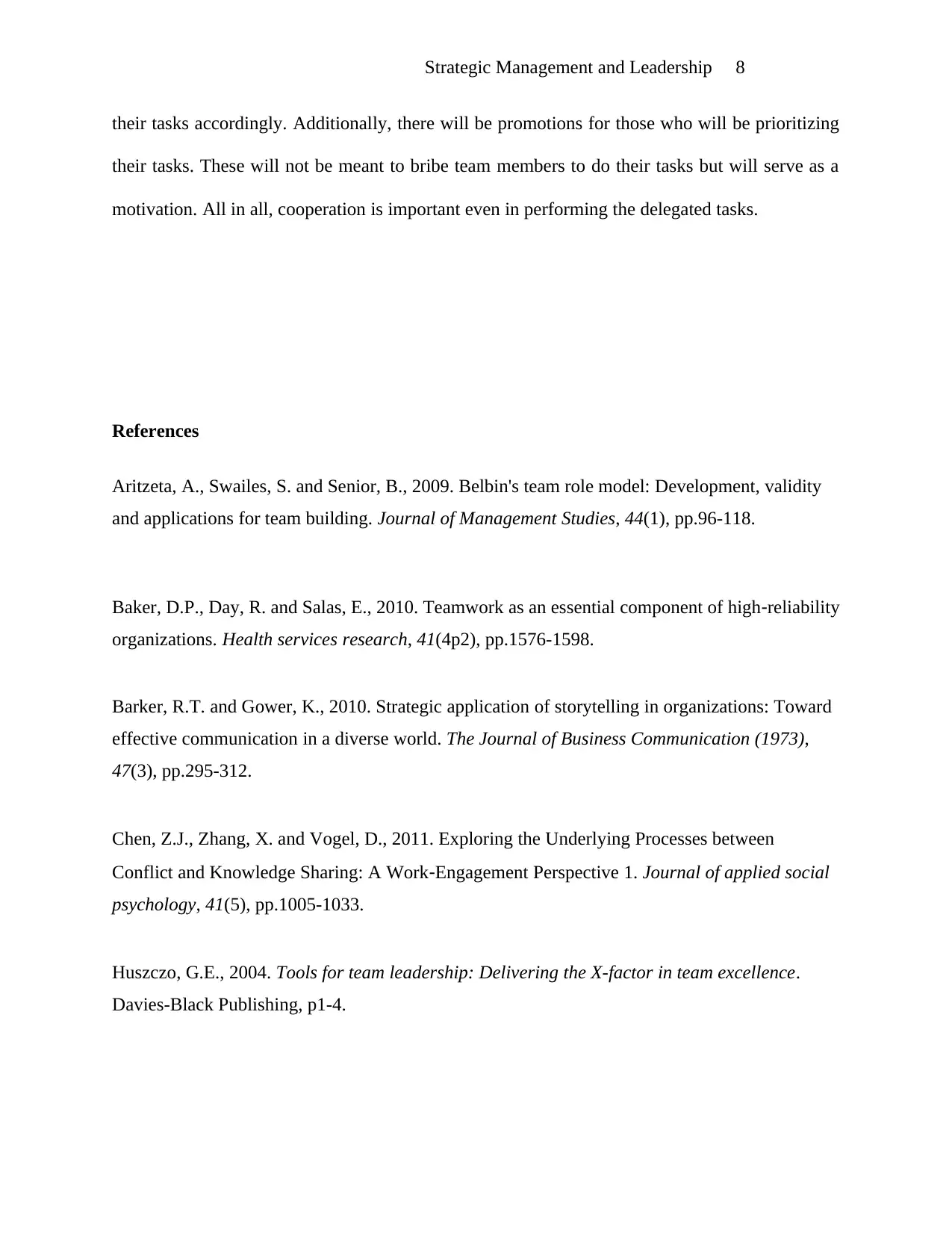
Strategic Management and Leadership 8
their tasks accordingly. Additionally, there will be promotions for those who will be prioritizing
their tasks. These will not be meant to bribe team members to do their tasks but will serve as a
motivation. All in all, cooperation is important even in performing the delegated tasks.
References
Aritzeta, A., Swailes, S. and Senior, B., 2009. Belbin's team role model: Development, validity
and applications for team building. Journal of Management Studies, 44(1), pp.96-118.
Baker, D.P., Day, R. and Salas, E., 2010. Teamwork as an essential component of high‐reliability
organizations. Health services research, 41(4p2), pp.1576-1598.
Barker, R.T. and Gower, K., 2010. Strategic application of storytelling in organizations: Toward
effective communication in a diverse world. The Journal of Business Communication (1973),
47(3), pp.295-312.
Chen, Z.J., Zhang, X. and Vogel, D., 2011. Exploring the Underlying Processes between
Conflict and Knowledge Sharing: A Work‐Engagement Perspective 1. Journal of applied social
psychology, 41(5), pp.1005-1033.
Huszczo, G.E., 2004. Tools for team leadership: Delivering the X-factor in team excellence.
Davies-Black Publishing, p1-4.
their tasks accordingly. Additionally, there will be promotions for those who will be prioritizing
their tasks. These will not be meant to bribe team members to do their tasks but will serve as a
motivation. All in all, cooperation is important even in performing the delegated tasks.
References
Aritzeta, A., Swailes, S. and Senior, B., 2009. Belbin's team role model: Development, validity
and applications for team building. Journal of Management Studies, 44(1), pp.96-118.
Baker, D.P., Day, R. and Salas, E., 2010. Teamwork as an essential component of high‐reliability
organizations. Health services research, 41(4p2), pp.1576-1598.
Barker, R.T. and Gower, K., 2010. Strategic application of storytelling in organizations: Toward
effective communication in a diverse world. The Journal of Business Communication (1973),
47(3), pp.295-312.
Chen, Z.J., Zhang, X. and Vogel, D., 2011. Exploring the Underlying Processes between
Conflict and Knowledge Sharing: A Work‐Engagement Perspective 1. Journal of applied social
psychology, 41(5), pp.1005-1033.
Huszczo, G.E., 2004. Tools for team leadership: Delivering the X-factor in team excellence.
Davies-Black Publishing, p1-4.
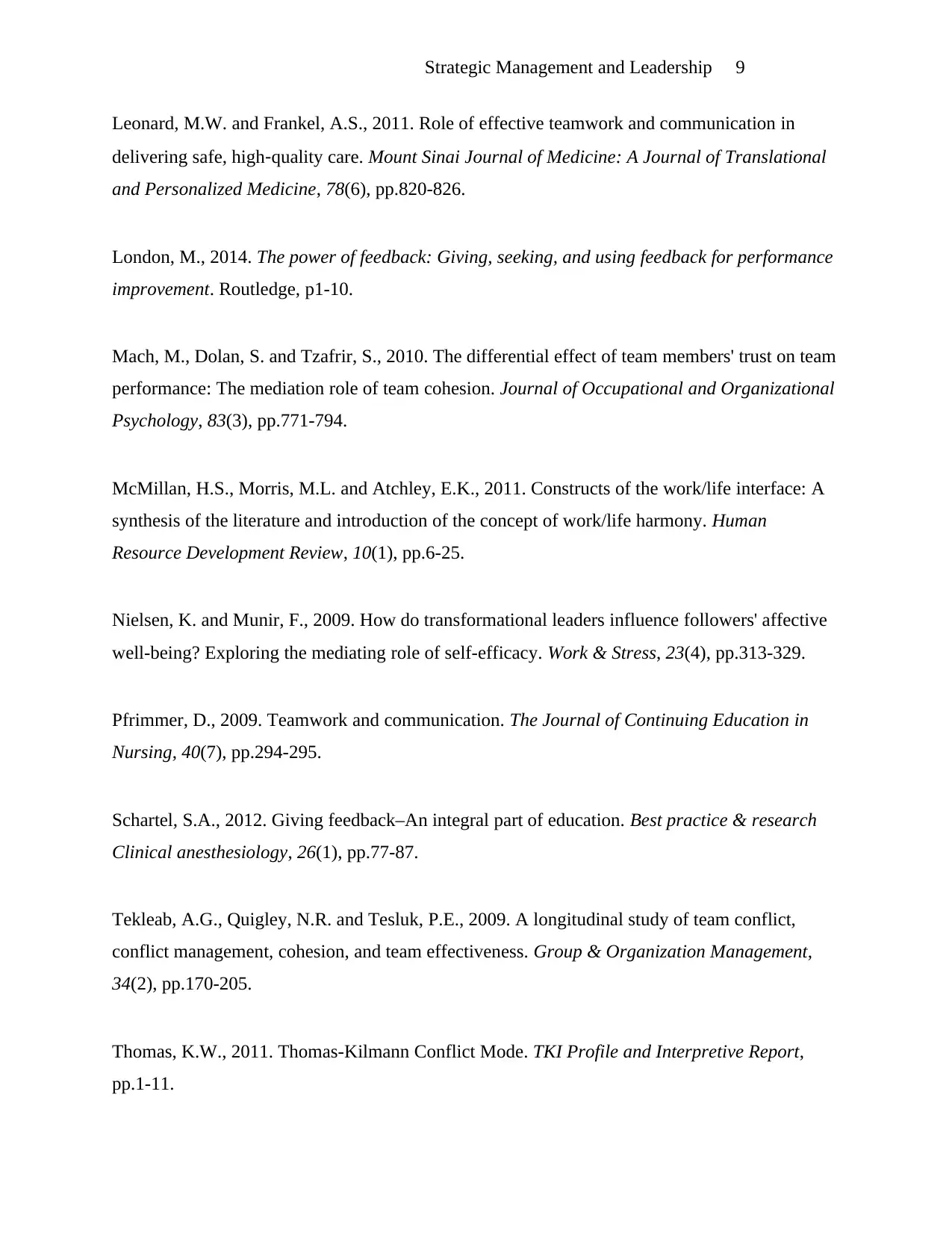
Strategic Management and Leadership 9
Leonard, M.W. and Frankel, A.S., 2011. Role of effective teamwork and communication in
delivering safe, high‐quality care. Mount Sinai Journal of Medicine: A Journal of Translational
and Personalized Medicine, 78(6), pp.820-826.
London, M., 2014. The power of feedback: Giving, seeking, and using feedback for performance
improvement. Routledge, p1-10.
Mach, M., Dolan, S. and Tzafrir, S., 2010. The differential effect of team members' trust on team
performance: The mediation role of team cohesion. Journal of Occupational and Organizational
Psychology, 83(3), pp.771-794.
McMillan, H.S., Morris, M.L. and Atchley, E.K., 2011. Constructs of the work/life interface: A
synthesis of the literature and introduction of the concept of work/life harmony. Human
Resource Development Review, 10(1), pp.6-25.
Nielsen, K. and Munir, F., 2009. How do transformational leaders influence followers' affective
well-being? Exploring the mediating role of self-efficacy. Work & Stress, 23(4), pp.313-329.
Pfrimmer, D., 2009. Teamwork and communication. The Journal of Continuing Education in
Nursing, 40(7), pp.294-295.
Schartel, S.A., 2012. Giving feedback–An integral part of education. Best practice & research
Clinical anesthesiology, 26(1), pp.77-87.
Tekleab, A.G., Quigley, N.R. and Tesluk, P.E., 2009. A longitudinal study of team conflict,
conflict management, cohesion, and team effectiveness. Group & Organization Management,
34(2), pp.170-205.
Thomas, K.W., 2011. Thomas-Kilmann Conflict Mode. TKI Profile and Interpretive Report,
pp.1-11.
Leonard, M.W. and Frankel, A.S., 2011. Role of effective teamwork and communication in
delivering safe, high‐quality care. Mount Sinai Journal of Medicine: A Journal of Translational
and Personalized Medicine, 78(6), pp.820-826.
London, M., 2014. The power of feedback: Giving, seeking, and using feedback for performance
improvement. Routledge, p1-10.
Mach, M., Dolan, S. and Tzafrir, S., 2010. The differential effect of team members' trust on team
performance: The mediation role of team cohesion. Journal of Occupational and Organizational
Psychology, 83(3), pp.771-794.
McMillan, H.S., Morris, M.L. and Atchley, E.K., 2011. Constructs of the work/life interface: A
synthesis of the literature and introduction of the concept of work/life harmony. Human
Resource Development Review, 10(1), pp.6-25.
Nielsen, K. and Munir, F., 2009. How do transformational leaders influence followers' affective
well-being? Exploring the mediating role of self-efficacy. Work & Stress, 23(4), pp.313-329.
Pfrimmer, D., 2009. Teamwork and communication. The Journal of Continuing Education in
Nursing, 40(7), pp.294-295.
Schartel, S.A., 2012. Giving feedback–An integral part of education. Best practice & research
Clinical anesthesiology, 26(1), pp.77-87.
Tekleab, A.G., Quigley, N.R. and Tesluk, P.E., 2009. A longitudinal study of team conflict,
conflict management, cohesion, and team effectiveness. Group & Organization Management,
34(2), pp.170-205.
Thomas, K.W., 2011. Thomas-Kilmann Conflict Mode. TKI Profile and Interpretive Report,
pp.1-11.
⊘ This is a preview!⊘
Do you want full access?
Subscribe today to unlock all pages.

Trusted by 1+ million students worldwide
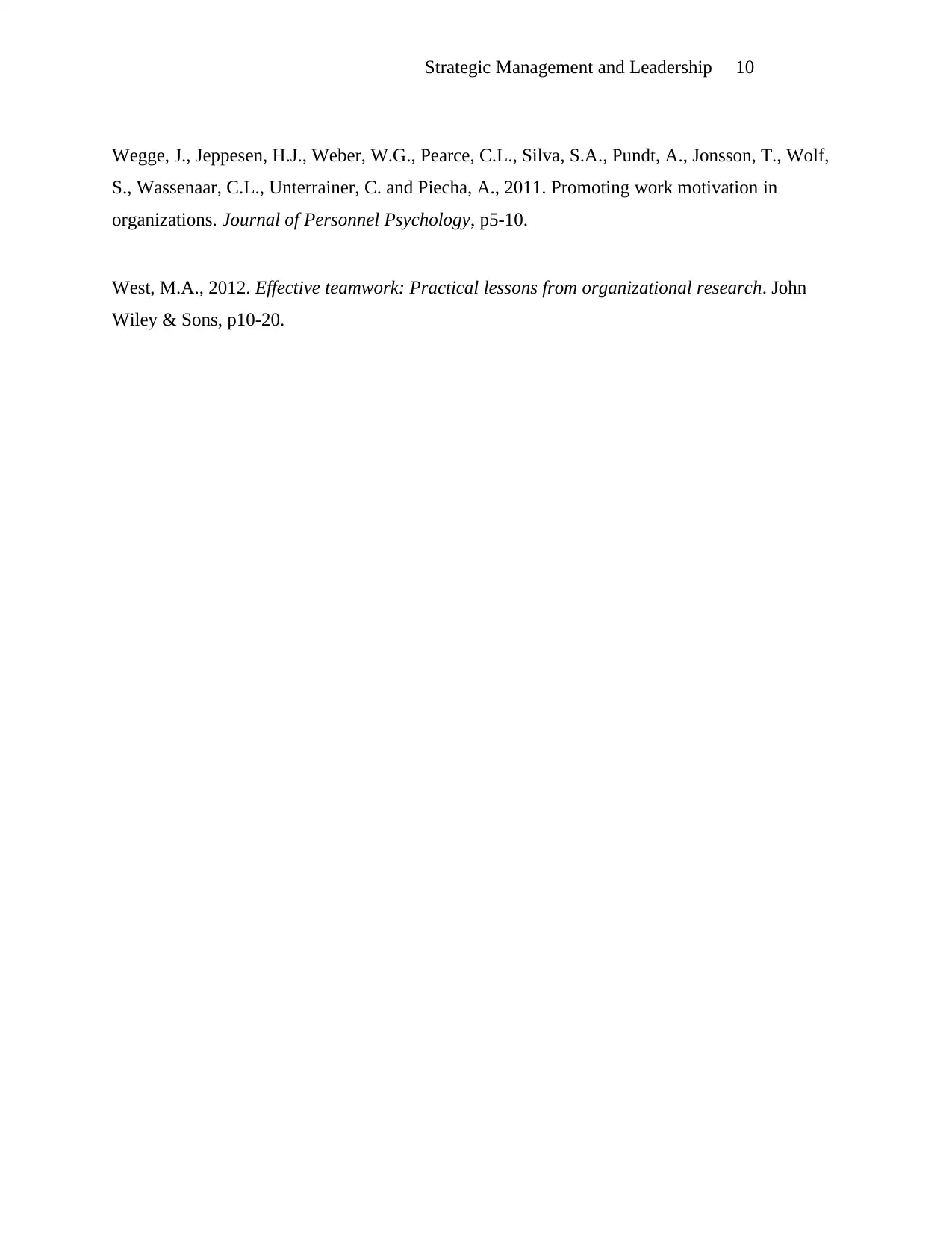
Strategic Management and Leadership 10
Wegge, J., Jeppesen, H.J., Weber, W.G., Pearce, C.L., Silva, S.A., Pundt, A., Jonsson, T., Wolf,
S., Wassenaar, C.L., Unterrainer, C. and Piecha, A., 2011. Promoting work motivation in
organizations. Journal of Personnel Psychology, p5-10.
West, M.A., 2012. Effective teamwork: Practical lessons from organizational research. John
Wiley & Sons, p10-20.
Wegge, J., Jeppesen, H.J., Weber, W.G., Pearce, C.L., Silva, S.A., Pundt, A., Jonsson, T., Wolf,
S., Wassenaar, C.L., Unterrainer, C. and Piecha, A., 2011. Promoting work motivation in
organizations. Journal of Personnel Psychology, p5-10.
West, M.A., 2012. Effective teamwork: Practical lessons from organizational research. John
Wiley & Sons, p10-20.
1 out of 10
Related Documents
Your All-in-One AI-Powered Toolkit for Academic Success.
+13062052269
info@desklib.com
Available 24*7 on WhatsApp / Email
![[object Object]](/_next/static/media/star-bottom.7253800d.svg)
Unlock your academic potential
Copyright © 2020–2025 A2Z Services. All Rights Reserved. Developed and managed by ZUCOL.





